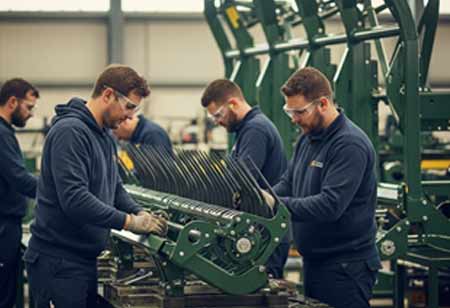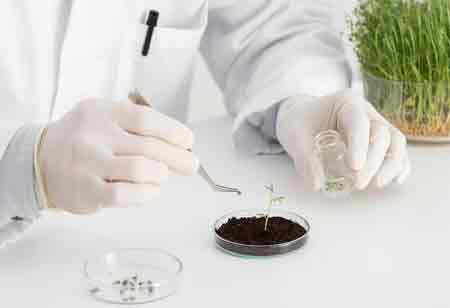Thank you for Subscribing to Agri Business Review Weekly Brief
The Shift Toward Sustainability in Hay Accumulator Systems
The hay accumulator systems industry is evolving with automation, sustainability, and customization, facing cost and complexity challenges while embracing global expansion and smart technology integration.

By
Agri Business Review | Friday, October 03, 2025
Stay ahead of the industry with exclusive feature stories on the top companies, expert insights and the latest news delivered straight to your inbox. Subscribe today.
The hay accumulator systems manufacturing industry stands at the intersection of tradition and innovation, where time-honored farming methods are being transformed by cutting-edge technology. As agriculture evolves to prioritize efficiency, sustainability, and automation, manufacturers are challenged to create solutions that enhance productivity while meeting the complex demands of modern farming. By automating the labor-intensive tasks of hay gathering and stacking, these systems play a vital role in helping farmers lower operational costs and minimize environmental impact.
Emerging Trends in the Industry
The hay accumulator systems industry has seen a shift towards automation and increased efficiency in harvesting processes. With the demand for higher productivity and reduced labor costs, manufacturers focus on developing systems that can minimize manual effort and improve operational efficiency. The trend toward automation is driven by the need for quicker and more effective ways to harvest, stack, and store hay.
There is a growing priority on environmental sustainability in agricultural equipment manufacturing. Hay accumulator systems are designed to reduce the carbon footprint of traditional farming practices. Manufacturers are integrating more energy-efficient components and focusing on designing systems that minimize fuel consumption while maximizing performance.
Another emerging trend in the industry is the customization of hay accumulator systems. As agricultural practices vary widely across regions and types of farming, manufacturers are adapting their products to satisfy the specific needs of different farming operations. This includes design, size, and functionality modifications, allowing farmers to select systems that best suit their operational requirements.
Challenges in the Sector
One of the manufacturers' most prominent challenges with hay accumulator systems is the high initial equipment cost. The upfront cost of acquiring a hay accumulator can be prohibitive for many small-scale farmers or those just beginning in the industry. The technological advancements and automation features incorporated into modern systems often contribute to this expense.
Manufacturers can address this challenge by offering financing choices or leasing programs that make it easier for farmers to access these systems without the burden of a significant initial investment. Producing modular or smaller-scale accumulator systems can help make these technologies more accessible to a broader range of farmers. Over time, as technology evolves, the cost of production may decrease, allowing manufacturers to pass savings on to consumers.
Another challenge for hay accumulator systems manufacturers is the complexity involved in operating and maintaining their products. While these systems present significant advantages in terms of labor efficiency, they often require specialized training to operate effectively. Maintaining these advanced machines can be difficult and costly, especially for small-scale farmers without the technical expertise or resources to perform repairs.
Manufacturers can overcome this challenge by offering comprehensive training programs for users at the point of sale and through online platforms. Creating user-friendly designs that simplify maintenance and reduce the need for specialized knowledge can help mitigate this issue. Offering warranties or service packages that cover maintenance and repairs would also make it easier for farmers to maintain the equipment in optimal working conditions.
Hay accumulator systems are often exposed to harsh environmental conditions, such as dirt, dust, moisture, and fluctuating temperatures, which can affect their durability. Poorly designed components can wear down quickly, leading to frequent repairs and downtime, ultimately reducing productivity.
Manufacturers can address this issue by using high-quality, stable materials that are resistant to wear and tear caused by environmental factors. Advances in material science, such as corrosion-resistant metals and coatings, can be utilized to increase the longevity of key components. Conducting extensive field testing in different environmental conditions will help manufacturers understand potential vulnerabilities and design equipment better suited for such challenges.
Integrating advanced technologies like GPS, sensors, and automation into hay accumulator systems remains limited, which can avert these systems from reaching their full potential. In today’s competitive agricultural landscape, many farmers seek solutions that integrate seamlessly with their existing farm management software and equipment.
Manufacturers can invest in developing smart, connected accumulator systems that utilize modern technologies like GPS for precise stacking and sensors to optimize bale collection. Integration with IoT and data analytics platforms can also offer farmers insights into their equipment's efficiency and performance, helping them make informed decisions that improve farm management.
Opportunities and Progress in the Sector
As global demand for efficient farming solutions grows, hay accumulator system manufacturers have opportunities to expand into emerging markets with large agricultural sectors. Many countries still use traditional, labor-intensive hay harvesting methods, indicating significant potential for modern, efficient equipment.
By tailoring products to meet the specific needs of these markets, manufacturers can help farmers boost productivity while opening new revenue streams. Advances in material science, sensor technology, and automation allow for improved design and functionality. Focusing on research and development can lead to systems that operate faster, are more precise, and consume less energy, with AI and machine learning enabling predictive maintenance and autonomous operations.





